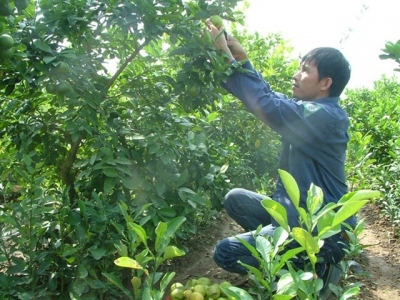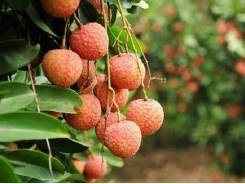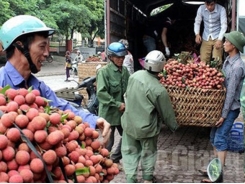Lime is the prize for innovative VN farmer

Nguyễn Hữu Hà nurses his seedless lime garden - the first of its kind in the northern province of Hưng Yên. — VNA/VNS Photo Văn Giáp
HƯNG YÊN — When it comes to seedless lime farming in Việt Nam, farmers across the country immediately think about a man with the nick name Hà Chanh Tứ quý (Hà Lime). He was the first person to grow Australian seedless limes in the northern province of Hưng Yên.
Nguyễn Hữu Hà, 40 years old, now has over 30 mẫu (each mẫu is equal to 3,600 sq.m) of Persian limes in Tân Dân Commune, Hưng Yên Province. The province is renowned as being the land of longans in Việt Nam with more than 3,000ha of longan harvested annually.
Lime farming helps him generate more than VNĐ5 billion (US$218,000) a year, and provides regular work for more than 30 people who get a stable monthly salary of VNĐ4 million.
Limes from Hà’s farm are now available in dozens of super markets and supply chains that commit to providing customers with clean farming products which are produced responsibly with minimal chemical inputs.
Since 2016 he has connected with lime growers across the country to form Phú Quý Farming Co-operatives to promote lime production and consumption.
Hà provided them seedlings, transferred farming techniques and also sought markets for their products.
Hà now has 60 ‘satellite’ lime farms with a total area of 120ha across 12 provinces nationwide.
He is also growing over 1,000 bonsai lime trees for the next lunar New Year festival after a successful pilot harvest which helped him earn billions extra last year.
Hà said that a bonsai lime tree can be priced from VNĐ2 million ($87) to VNĐ60 million ($2,600).
“Some customers prefer strange and unique ornamental trees for Tết (Lunar New Year) rather than traditional ones like kumquat or peach,” Hà said, adding that lime trees were liked as they stayed green and good looking for long.
Journey to success
Before growing limes, he used to be a newsboy, a fruit wholesaler, a litchi grower and a guest worker in Russia.
“Longans and litchis are both specialty fruits in Việt Nam, but farmers usually fall into the scenario where a bumper crop is accompanied by a dropping price,” Hà said.
“I wanted to make something different, at least, a different fruit to grow on my land,” Hà said.
“I chose limes because they are not a specialty fruit, but they are used in every family’s daily life. They also weren’t grown widely in my hometown,” Hà said.
“While I worked in Russia I met a university lecturer – he was a PhD student at that time, he showed me where to buy Australian lime seeds,” Hà said.
Persian limes, also known as seedless limes, Bearss lime and Tahiti lime, are a citrus fruit species of hybrid origin, known only in cultivation. The Persian lime is a triploid cross between key lime and lemon.
Starting with an initial investment of VNĐ15 million ($660) in 2012, he began importing Persian lime seeds from Australia and the US. Hà earned VNĐ30 million ($1,220) from 7 sào (one sào equals 360 sq.m) in the first year.
“As soon as I talked about replacing my longans with limes, no one in my family gave me any favours anymore,” Hà said.
Lime farming turned out to be more difficult because the imported fruit trees did not adapt well to the local soil. They grew poorly and suffered from diseases.
The problem was solved after Hà accidentally saw chanh đào (Citrus limonia – a variety of lemon with rosy pulp) growing on a grapefruit tree. Hà then tried grafting Persian lime and grape fruit rootstock together.
“As grape fruit root is strong, the combined plants grow well, and suffer fewer diseases. They generating high yields,” Hà said.
Unlike local limes which take 15 months before they can be harvested, and produce just 10-20kg per tree, Persian limes take only 3-5 months until they’re ready to harvest (from February to June) and each Persian lime tree can generate 100kg of lime per year.
The farmer uses soybean powder as a fertiliser to provide nutrition for the plants and help fend off diseases.
On average, a kilo of seedless limes is worth about VNĐ20,000, while the production cost is just VNĐ 5,000.
“In clean agricultural production, it’s so important to connect products with customers who have demand for them,” Hà emphasized.
“That’s the reason why as soon as I harvested my first limes, I introduced them to supermarkets and “clean food” stores in Hà Nội’s inner districts where I could meet customers demands for high quality and safe food,” Hà said.
Hà remembered the first time he met Trần Quân, director of a chain of food stores called Sói Biển (Sea Wolf).
“I told Quân that I had what he wanted. I became a supplier to Quân’s store,” Hà said, adding that his business grew together with Quân’s business as a result of the co-operation.
“There’s no time to produce and then wait for customers to come. Finding and approaching customers is an important step for farmers nowadays,” Hà said.
Hà said he plans to try other foreign lime varieties in his land, and expand his farms so that he can supply his own future limeade plant.
Social networks like Facebook also helped to connect Hà with other farmers and customers. In one of his recent posts, Hà took selfie photos in which he stands next to fruitful lime trees, smiling brightly. “I love and live with it!” the photo’s caption says.
Related news
Tools

Phối trộn thức ăn chăn nuôi

Pha dung dịch thủy canh

Định mức cho tôm ăn

Phối trộn phân bón NPK

Xác định tỷ lệ tôm sống

Chuyển đổi đơn vị phân bón

Xác định công suất sục khí

Chuyển đổi đơn vị tôm

Tính diện tích nhà kính

Tính thể tích ao



 200 tons of lychees exported to Thailand
200 tons of lychees exported to Thailand  More than 186,000 tons of lychees consumed
More than 186,000 tons of lychees consumed